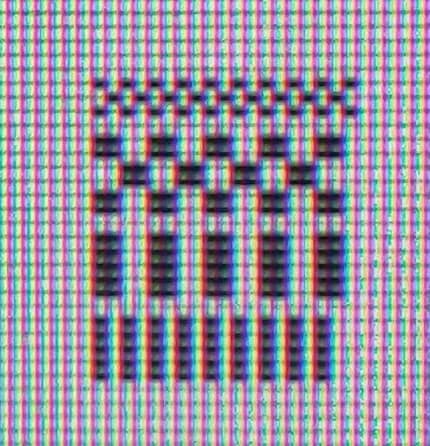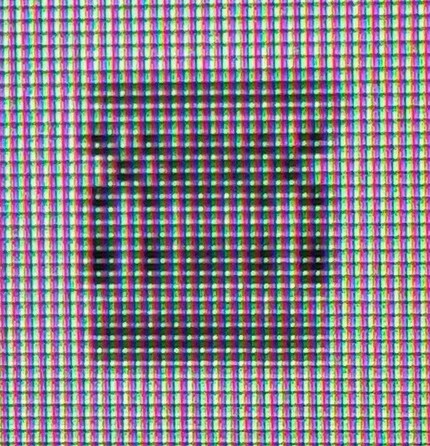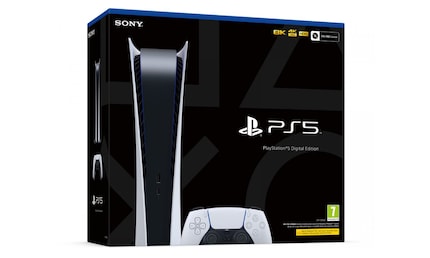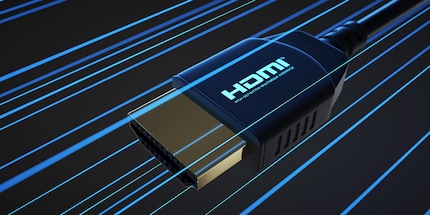
Background information
Here’s what you need to know about Samsung’s OLED TV comeback
by Luca Fontana

HDMI 2.1 was meant to be the Jesus of HDMI, the second coming if you will. The interface was heralded as the answer to transferring large amounts of data from next gen consoles to your TV. But now it seems to be creating more problems than solutions.
«Luca, which TV do you recommend for next gen consoles?» I always get asked this question, usually by e-mail. It’s not surprising when you consider a lot of people have a PlayStation 5 or Xbox Series X/S sat at home. And Swiss gamers want the perfect TV for their favourite hobby.
The answer should be straightforward, really. Previous generation consoles were still offering UHD resolution at 60 images or frames per seconds (fps), while the new generation boasts 120 fps or 60 fps in 8K. In order to be next-gen compatible, TVs have to be able to handle new data and much larger quantities of it.
The magic word here is HDMI 2.1. This is the new and improved interface between TVs and consoles.
And on that note, it’s time for a story about failing, featuring my favourite sacrilege word of the year, «firmware update».
In 2019, LG earned high praise for being the first TV manufacturer to build the new HDMI 2.1 interface into their TVs. Within the industry, the general consensus was LG TVs were «future-proof» – even I thought that. I mean, it was already clear in April 2019 that the new generation of consoles were right around the corner.
And then a year later, there was the first fairly decent-sized scandal, which when you look back on it, wasn’t even really a scandal. In May 2020, LG announced that their new generation of TVs did have HDMI 2.1, but the interface would be different to the version on 2019 TVs. Rather than the full HDMI 2.1 bandwidth of 48 Gbit/s it would «just» have 40 Gbit/s.
Many LG customers were concerned about whether the bandwidth would be enough to carry UHD and 120 fps. LG said yes – it can still support HDR UHD at 120 fps. OK, drama over. LG claimed their intelligent image and sound optimisation could achieve better results if processing capacity was diverted away from the HDMI 2.1 ports and made available to the TV’s AI features instead.
And now, LG’s 2020 OLED TVs are actually considered to be the best gaming TVs on the market. My colleague and gaming editor Phil agrees. He put the TV through its paces when he reviewed it as a gaming monitor.
So far, so good, HDMI 2.1.
Four months later, Forbes journalist John Archer was one of the first to come across an HDMI 2.1 feature that LG TVs struggled with: variable refresh rate.
Here’s the problem. Graphics cards have variable rendering rates, but TVs have a fixed refresh rate. If these two rates aren’t synchronised, you get stuttering and so-called image tearing. HDMI 2.1 combats this with a new feature called variable refresh rate (VRR).
If VRR is enabled on the TV, it’ll syncronise its refresh rate with the rendering rate on the console or PC graphics card. And that’s how they avoid tearing. However, John Archer found that enabling VRR made dark areas in games look more grey and washed out than black. It’s really noticeable on OLED TVs because their black is much darker than on LCD TVs.
There’s as yet no solution. But John reported that LG recognised there was a problem and its teams have been working to fix it.
Tech expert John Archer uncovered the story once again. This time, he was reporting on HDMI 2.1 problems linked with Nvidia’s latest generation of graphics cards and LG’s HDMI 2.1 TV. And once again, it was the variable refresh rate causing problems. Strictly speaking, it’s Nvidia’s own VRR system, G-Sync.
While blame was initially put on LG and its reduced 40-Gbit/s HDMI 2.1, it later became clear that compatibility issues were probably caused by the graphics card.
A month later and the number of compatibility issue reports wasn’t slowing. Quite the opposite. But what was new was the fact LG TVs weren’t the ones affected. This time it was Denon, Marantz and Yamaha receivers caught in media crossfire.
This was good news for LG, but not so great for the others. Up until now, cynics had argued that LG simply couldn’t keep up with the newest standard. But then along came Nvidia’s graphics card problems. And then issues with the receiver.
It begs the question, is the standard in and of itself too demanding? Is it too complicated? Is it incompatible with current hardware?
In the meantime, Denon, Marantz and Yamaha have been working away feverishly on a solution that should be unveiled «in the future». Perhaps. If the problem is indeed caused by the faulty hardware, no firmware update in the world will be able to resolve it.
Things get even worse for HDMI 2.1. Originally, the only VRR problems with LGs that John Archer talked about were washed out greys in dark areas. But he’s since discovered flickering and image artefacts in dark scenes when VRR is activated.
So, what did LG say?
The South Korean manufacturer doesn’t have a solution, but it has uncovered the source of the problem: gamma correction.
When the OLED TV uses frame rates less than 120 Hz, the gamma curve is inconsistent with the frame rate.
What does that mean? One of the quirks of the human eye is it doesn’t detect brightness difference on a linear scale. This means that it can’t recognise brightness difference as well in particularly dark or bright picture areas as it can in mid areas.
TVs correct this with the gamma curve. This ensures that colours in dark areas appear brighter and those in brighter areas appear darker than they actually are. That way, our eyes detect brightness differences linearly – in other words, equally well – in all picture areas. LG’s problem is that its gamma correction is designed for a refresh rate of 120 Hz or 120 fps. But when VRR is enabled, lower refresh rates are also possible.
Can it be fixed with a firmware update? LG prefers to keep its cards close to its chest. All we know is it’s working flat out on a solution. Vincent Teoh, on the other hand, reckons it’s unlikely a firmware update could resolve the problem completely.
In the video above, Vincent explains that he thinks it’s more likely an update would reduce the washed out greys and flickering than eliminate them entirely. But we probably won’t set eyes on that until next year, when the new generation of LG TVs are launched and LG incorporates knowledge gained into hardware developments.
However, what sounds like a complete disaster might actually be a non-issue getting blown out of proportion. After all, there are plenty of people in forums and comment sections that haven’t been affected by flickering problems or complained of washed out greys.
Our resident games editor Phil is one of then. «I have the LG CX myself. I’ve played over 30 hours of ‘Assassin’s Creed’ on the Xbox Series X with VRR enabled and never noticed any issues.»
The problem lies in the 14 October update. This was meant to have the TV «ready» for Playstation 5, but instead the news was it can’t display native UHD image in 120 Hz.
It didn’t take long before there was an outcry from the Sony community. Just like LG and Samsung, Sony uses an HDMI 2.1 interface with four data lanes at 10 Gbit/s each. In total that’s «only» 40 Gbit/s rather than the 48 Gbit/s bandwidth that’s technically available in the new HDMI standard. The assumption was the Sony TV didn’t have enough bandwidth, and word spread fast.
But is it true?
As probable as it sounds, it’s unlikely. After all, LG and Samsung still manage UHD at 120 fps despite a 40-Gigabit bandwidth. So, there’s nothing to say that Sony can’t achieve this too.
Let’s stay with Sony and pull Microsoft into the mix as well. Both manufacturers admitted that, for the moment, neither the Playstation 5 nor the Xbox Series X/S is capable of outputting native 8K signal. That’s in spite of the fact they advertise 8K. The Playstation even has a big 8K logo on the box.
That doesn’t mean the consoles aren’t capable of 8K at 60 fps. It’s just that the HDMI 2.1 feature isn’t enabled for now. Both manufacturers said they’d release a firmware update as soon as the first 8K games were developed. It sounds reasonable. But at the same time, it’s a shame that 8K TVs have to do the upscaling themselves for now.
However, that’s not the whole story in terms of HDMI 2.1. At least not for Sony. As recent reviews show, the Playstation 5 can’t handle variable refresh rates yet. That means no VRR for anyone.
Will there be a firmware update? It’s a mixture of hopefully, probably and let’s wait and see.
Let’s circle back to the Bravia XH90, Sony’s flagship gaming TV. A few days ago, Sony didn’t want to hear about any issues but now we hear they’ve linked the reported bugs – all of a sudden they’re not side effects anymore – to a software problem.
The result? Sony is working on, wait for it, a firmware update that should «deal with» the problem. Vincent Teoh notes that it isn’t clear if Sony can actually resolve the problem or if it just wants to work around it. For instance, by reducing the required bandwidth in UHD and 120 fps through chroma subsampling. This would allow you to achieve a native UHD image.
Dear reader, if you’re still wondering which TV to get for the next generation of consoles, the honest answer is, I don’t know. Yet.
We’ll just need to get used to that. Firmware updates are now just as regular as day 1 patches in «World of Warcraft». If you’re an early adopter of new technology, you run the risk of investing good money in undeveloped technology. You might be the first to get your hands on it, but it only really becomes more sophisticated in later versions.
And for that reason… if you can still put off buying an HDMI 2.1 TV, then I’d recommend waiting. At least until the 2021 TVs arrive and the manufacturers have ironed out any mistakes that current models are still making.
You let me know faster than any push notification in the world that there’s been movement again on the LG VRR front.
In short, a firmware update could indeed eliminate the problem or at least reduce it significantly. Thanks to readers Anonymous and Titanx for updating me so quickly.
I write about technology as if it were cinema, and about films as if they were real life. Between bits and blockbusters, I’m after stories that move people, not just generate clicks. And yes – sometimes I listen to film scores louder than I probably should.
Interesting facts about products, behind-the-scenes looks at manufacturers and deep-dives on interesting people.
Show allIn which case, it should be quite easy. If your TV supports HDMI 2.1, you’re on the bright side of console life, aren’t you? If only. HMDI 2.1 has been giving manufacturers so many headaches that for the last few weeks, hardly a day has gone by when we don’t hear of some other scandal. It’s usually along the lines of «HDMI 2.1 doesn’t work on insert brand name here» or «they’re working on a firmware update, but no one knows how, when or if it’ll ever be released».
This problem has since been resolved with a new LG firmware update and Nvidia graphics card driver. At least, that’s the reports coming in from tech forums and Vincent Teoh, who’s known, amongst other talents, for being a TV calibrator and tester at HDTVTest. If you still have difficulty with your Nvidia graphics card, have a look at this. Some other people seemed to still have problems after the firmware and driver update, but have since managed to resolve them.
What we know for sure is that all three manufacturers use the same HDMI 2.1 chipset from Panasonic Solutions. These chipsets seem to be faulty, as they’re not properly controlling the four data lanes in the HDMI 2.1, where each carries 12 Gbit/s (48 Gbit/s in total). This results in black screen issues on the TV. That’s something we’ve already discussed in German on the digitec podcast.
Let me give you an example. In a graphics-intense scene, the refresh rate drops for a few seconds from 120 fps to 60 fps. During this time, the picture only loads 60 times per second rather than 120. Put differently, enabling VRR results in each frame being displayed twice as long as before. According to LG, this results in «overcharging» of pixels in these frames because the gamma curve is optimised for 120 fps. This in turn leads to the problems John Archer identified.
We hit a crescendo with HDMI 2.1 causing problems everywhere. Now Sony is affected, too. How ironic. They’re in the process of releasing the Playstation 5. The Japanese manufacturer is putting forward the Bravia XH90 as its flagship gaming TV. It’s supposed to be perfect for the Playstation 5 and together with its next-gen console, also ideal for gamers.
4kfilme.de thinks that in game mode, the picture is first rendered in HD and 120 fps before being uprezzed to UHD. You can see it in fonts, text and straight lines that look blurry rather than razor-sharp.You can see it in fonts, text and straight lines that look blurry rather than razor-sharp. It’s a clear sign of fake, non-native UHD.


But Sony is denying any problems. In an initial statement to Vincent Teoh, dated 27 October, Sony argues that the Bravia XH90 delivers an extremely smooth display, which is the most important thing for gamers. It goes on to say that side effects mentioned were linked to the fact UHD needs a higher bandwidth at 120 Hz. But in a moving image, you most likely wouldn’t even notice these side effects.

But we’re just grasping at assumptions. We won’t know anything for sure until the firmware update is here. And when that will be, no one knows. But Sony has asked us to keep checking this site regularly until the firmware update arrives. Vincent said in one of his previous videos: «I’m actually a professional TV tester. But at the moment I feel like a professional firmware update tester.»

What makes me say that? This whole HDMI 2.1 saga. It’s unpredictable and anybody’s guess. What's more, it shows that televisions have long since ceased to be bullish monitors that only display image information. Instead, they’re modern computers that compute, process and interact with external hardware and software. When new technology and standards are in the mix, teething problems aren’t unheard of. And in the case of HDMI 2.1, it leads to more than many people thought possible.